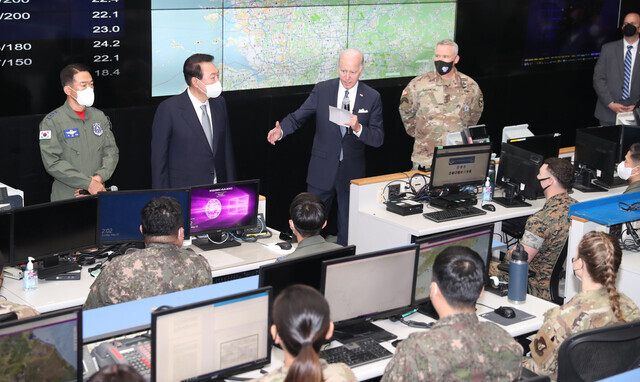hankyoreh
Links to other country sites 다른 나라 사이트 링크
[Editorial] In siding with US, S. Korea faces uphill path to peace, balance

US President Joe Biden’s three-day trip to South Korea began with a visit to a Samsung Electronics factory with South Korean President Yoon Suk-yeol and concluded on Sunday with a visit to the Korean Air and Space Operations Center (KAOC) in Osan, which oversees aerospace operations in the vicinity of the Korean Peninsula. The trip included numerous hints at the US’ strategy of containing China by expanding the Korea-US alliance — which has hitherto been focused on the security of the Korean Peninsula — into a values-based alliance, a global strategic alliance, and even an “economic security alliance” that is oriented on semiconductors.
The Yoon administration has chosen to go along with the US while actively cooperating with those moves. As Korea throws its weight behind the US at a time of rapid changes in the international order, tensions have risen on the Korean Peninsula and the Chinese risk has grown.
While discussing national security during their summit on Saturday, Yoon and Biden emphasized strengthening the deterrent against North Korea. In their joint statement, they agreed “to expand the scope and scale of combined military exercises and training on and around the Korean Peninsula” and confirmed “the US extended deterrence commitment to the ROK using the full range of US defense capabilities, including nuclear, conventional, and missile defense capabilities.”
There is certainly a need to respond to North Korea’s launch of intercontinental ballistic missiles and its preparations for nuclear tests. But Yoon and Biden seem to have forgotten the basic principle that not only pressure but also dialogue are needed to resolve the North Korean nuclear issue and to maintain peace on the Korean Peninsula.
Despite what Seoul and Washington have said about remaining open to dialogue with Pyongyang, they do not appear to be working toward dialogue or diplomacy, and the only thing in evidence is the policy of deterrence that Pyongyang has long protested.
Neither the Panmunjom Declaration nor the Singapore summit was mentioned in this year’s joint statement, as they were last year. One can’t help worrying that we will return to the perilous situation at the end of 2017 when North Korea was at loggerheads with both the US and South Korea and Trump was threatening “fire and fury” in response to North Korean nuclear weapon tests.
We must also bear in mind that South Korea and the US’ agreement to a sweeping expansion of the scope of their alliance to include semiconductors, batteries, cyber threats, outer space, cooperation on nuclear reactors and public health, and global issues could turn out to be a double-edged sword for Korea. Seoul has made official its intention to join the US-led Indo-Pacific Economic Framework (IPEF) and has promised to “develop, use, and advance technologies in line with shared democratic principles and universal values.”
While China was not mentioned in the joint statement, there are numerous signals that its content was targeting China, considering that the country does not comport with the values that the US has advocated for this “democratic values” alliance.
Along with reemphasizing “peace and stability in the Taiwan Strait,” following a similar mention in last year’s summit, the two countries obliquely criticized the human rights in China by referring to “mutual concerns regarding human rights situations in the Indo-Pacific region.”
The US has achieved its specifically desired goals, including Korea joining the IPEF, the expansion of the Korea-US alliance, and large-scale investments by Korean companies including Samsung and the Hyundai Motor Group. But Korea’s real gains have been vaguer, and its liabilities have grown.
The summit is over, but we hope that the government will pay attention to the serious questions it must now answer about how to manage the preordained rise of tensions on the Korean Peninsula and the economic and diplomatic risks posed by China and how to cover the bill for the US upgrading Korea into a global ally.
Please direct questions or comments to [english@hani.co.kr]

Editorial・opinion
![[Column] Life on our Trisolaris [Column] Life on our Trisolaris](https://flexible.img.hani.co.kr/flexible/normal/500/300/imgdb/original/2024/0505/4817148682278544.jpg) [Column] Life on our Trisolaris
[Column] Life on our Trisolaris![[Editorial] Penalties for airing allegations against Korea’s first lady endanger free press [Editorial] Penalties for airing allegations against Korea’s first lady endanger free press](https://flexible.img.hani.co.kr/flexible/normal/500/300/imgdb/original/2024/0502/1817146398095106.jpg) [Editorial] Penalties for airing allegations against Korea’s first lady endanger free press
[Editorial] Penalties for airing allegations against Korea’s first lady endanger free press- [Editorial] Yoon must halt procurement of SM-3 interceptor missiles
- [Guest essay] Maybe Korea’s rapid population decline is an opportunity, not a crisis
- [Column] Can Yoon steer diplomacy with Russia, China back on track?
- [Column] Season 2 of special prosecutor probe may be coming to Korea soon
- [Column] Park Geun-hye déjà vu in Yoon Suk-yeol
- [Editorial] New weight of N. Korea’s nuclear threats makes dialogue all the more urgent
- [Guest essay] The real reason Korea’s new right wants to dub Rhee a founding father
- [Column] ‘Choson’: Is it time we start referring to N. Korea in its own terms?
Most viewed articles
- 160% of young Koreans see no need to have kids after marriage
- 2Presidential office warns of veto in response to opposition passing special counsel probe act
- 3New sex-ed guidelines forbid teaching about homosexuality
- 4Months and months of overdue wages are pushing migrant workers in Korea into debt
- 5OECD upgrades Korea’s growth forecast from 2.2% to 2.6%
- 6[Guest essay] Maybe Korea’s rapid population decline is an opportunity, not a crisis
- 7[Column] Life on our Trisolaris
- 8Another chaebol heir caught smuggling liquid marijuana into South Korea
- 9S. Korea discusses participation in defense development with AUKUS alliance
- 10Bills for Itaewon crush inquiry, special counsel probe into Marine’s death pass National Assembly